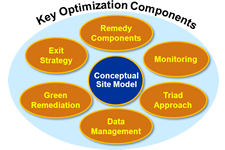Overview
Key Optimization Components: Conceptual Site Model
 A project life cycle conceptual site model (CSM) is a comprehensive graphical and written summary of what is known or hypothesized about environmental contamination at a site and the relationships among key site information that are pertinent to decision-making. A CSM is a representation that evolves over the life cycle of site investigation and cleanup efforts. It provides a platform for evaluating the data gaps and related uncertainty associated with site history and operations; geology, hydrogeology and hydrology; contaminant sources, release mechanisms and fate and transport; potential receptors and exposure pathways. The development of an accurate CSM is vital to the project and site decision-making process.
A project life cycle conceptual site model (CSM) is a comprehensive graphical and written summary of what is known or hypothesized about environmental contamination at a site and the relationships among key site information that are pertinent to decision-making. A CSM is a representation that evolves over the life cycle of site investigation and cleanup efforts. It provides a platform for evaluating the data gaps and related uncertainty associated with site history and operations; geology, hydrogeology and hydrology; contaminant sources, release mechanisms and fate and transport; potential receptors and exposure pathways. The development of an accurate CSM is vital to the project and site decision-making process.
A project life cycle CSM is comprised of six stages, as described below:
- Preliminary CSM Stage – Site representation based on existing data; conducted prior to systematic planning efforts.
- Baseline CSM Stage – Site representation used to gain stakeholder consensus or disagreement, identifies data gaps and uncertainties; conducted as part of the systematic planning process.
- Characterization CSM Stage – Continual updating of the CSM as new data or information is received during investigations; supports remedy decision making.
- Design CSM Stage – Targeted updating of the CSM to support remedy design.
- Remediation/Mitigation CSM Stage – Continual updating of the CSM during remedy implementation; and providing the basis for demonstrating the attainment of cleanup objectives.
- Post Remedy CSM Stage – The CSM at this stage is used to support reuse planning and placement of institutional controls if warranted.
Selected Resources
Click on a column heading to sort the table. Search for additional publications or resources by keyword or topic using the Search page.




